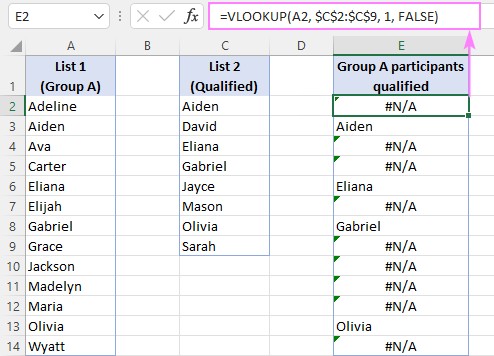VLOOKUP is a powerful Excel function that can be used to compare two columns and identify matching or missing data. At COMPARE.EDU.VN, we provide comprehensive guides to help you master this function and other data comparison techniques. Learn how to leverage VLOOKUP for efficient data analysis.
1. Understanding the Basics of VLOOKUP for Column Comparison
VLOOKUP, which stands for “Vertical Lookup,” is a function in Excel that allows you to search for a specific value in the first column of a range and then return a value from any column in the same row. When comparing two columns, VLOOKUP can quickly identify common entries or highlight discrepancies.
1.1. VLOOKUP Syntax Explained
The VLOOKUP function has four arguments:
- lookup_value: The value you want to search for.
- table_array: The range of cells in which to search. The lookup_value is always searched in the first column of this range.
- col_index_num: The column number in the table_array from which to return a matching value.
- range_lookup: A logical value (TRUE or FALSE) that specifies whether to find an approximate or exact match. For comparing columns, you typically want an exact match, so you’d use FALSE.
Understanding this syntax is crucial for effectively using VLOOKUP for column comparison.
1.2. Setting Up Your Data for VLOOKUP
Before using VLOOKUP, organize your data into two columns that you want to compare. Ensure that the data is clean and consistent to avoid errors. Having a structured approach helps ensure accurate results.
2. Step-by-Step Guide: Using VLOOKUP to Compare Two Columns
Here’s how to use VLOOKUP to compare two columns in Excel:
2.1. Basic VLOOKUP Formula for Matching Values
Suppose you have two columns: Column A with a list of names, and Column B with another list of names. To find the names in Column A that also appear in Column B, use the following formula:
=VLOOKUP(A2, $B$2:$B$100, 1, FALSE)
This formula searches for the value in cell A2 within the range B2:B100. If it finds an exact match, it returns the value from the first column (column 1) of the range. If no match is found, it returns a #N/A error.
2.2. Handling #N/A Errors with IFNA and IFERROR
The #N/A error can be unsightly and confusing. To handle these errors, use the IFNA or IFERROR functions. IFNA is specifically designed for handling #N/A errors, while IFERROR handles all types of errors.
Using IFNA:
=IFNA(VLOOKUP(A2, $B$2:$B$100, 1, FALSE), "")
This formula returns an empty string (“”) if VLOOKUP returns a #N/A error, making the cell appear blank.
Using IFERROR:
=IFERROR(VLOOKUP(A2, $B$2:$B$100, 1, FALSE), "")
This formula does the same as IFNA but catches all types of errors, not just #N/A.
2.3. Comparing Columns in Different Excel Sheets
Often, the columns you want to compare might be in different sheets. To reference a column in another sheet, use the following syntax:
=IFNA(VLOOKUP(A2, Sheet2!$A$2:$A$100, 1, FALSE), "")
This formula searches for the value in cell A2 of the current sheet within the range A2:A100 of Sheet2.
3. Advanced Techniques: Beyond Basic Column Comparison
Once you’re comfortable with the basics, you can use VLOOKUP for more advanced comparison tasks.
3.1. Returning Common Values Without Gaps
To get a clean list of common values without gaps, you can use the FILTER function in combination with VLOOKUP. This is particularly useful in Excel 365 and later versions that support dynamic arrays.
=FILTER(A2:A100, IFNA(VLOOKUP(A2:A100, B2:B100, 1, FALSE), "")<>"")
This formula filters the range A2:A100, returning only the values that are found in the range B2:B100.
3.2. Finding Missing Values (Differences)
To find values that are present in one column but not in the other, use the ISNA function to check for #N/A errors.
=IF(ISNA(VLOOKUP(A2, $B$2:$B$100, 1, FALSE)), A2, "")
This formula returns the value from cell A2 if it’s not found in the range B2:B100. Applying a filter to remove blanks will give you a list of unique values.
In Excel 365 and later versions, you can use the FILTER function for a dynamic result:
=FILTER(A2:A100, ISNA(VLOOKUP(A2:A100, B2:B100, 1, FALSE)))
3.3. Identifying Matches and Differences with Text Labels
To add text labels indicating whether a value is present in both columns or only in one, combine VLOOKUP with the IF and ISNA functions.
=IF(ISNA(VLOOKUP(A2, $B$2:$B$100, 1, FALSE)), "Not in List 2", "In List 2")
This formula returns “Not in List 2” if the value in A2 is not found in B2:B100, and “In List 2” if it is found.
4. Practical Examples and Use Cases
Understanding how to apply VLOOKUP in real-world scenarios can greatly enhance your data analysis skills.
4.1. Comparing Customer Lists
Suppose you have two customer lists: one from your CRM system and another from a recent marketing campaign. Use VLOOKUP to identify customers who are in both lists, allowing you to target specific marketing efforts.
4.2. Identifying Inventory Discrepancies
Compare your inventory records with actual stock levels to identify discrepancies. This helps in managing stock more effectively and reducing losses.
4.3. Validating Data Entries
Use VLOOKUP to validate data entries against a master list. For example, ensure that all product codes entered in a sales sheet are valid by comparing them against a list of authorized codes.
4.4. Matching Financial Transactions
Match transactions between two different financial systems to ensure accuracy and completeness. This is particularly useful during audits or system migrations.
5. Alternative Functions for Column Comparison
While VLOOKUP is powerful, Excel offers other functions that can be used for column comparison, each with its own advantages.
5.1. MATCH Function
The MATCH function returns the position of a value in a range. It is useful when you need to know where a value is located rather than the value itself.
=MATCH(A2, $B$2:$B$100, 0)
This formula returns the row number where the value in A2 is found in the range B2:B100. If the value is not found, it returns a #N/A error.
5.2. INDEX and MATCH Combination
INDEX and MATCH can be combined to perform more flexible lookups than VLOOKUP. INDEX returns the value at a given position in a range, and MATCH finds the position of a value.
=INDEX($B$2:$B$100, MATCH(A2, $A$2:$A$100, 0))
This formula finds the value in column B that corresponds to the value in column A. The MATCH function finds the row number where the value in A2 is found in the range A2:A100, and the INDEX function returns the value from that row in the range B2:B100.
5.3. XLOOKUP Function
XLOOKUP is the modern successor to VLOOKUP and HLOOKUP, available in Excel 365 and later versions. It offers several advantages, including the ability to search in any column and return values from any other column, without being restricted to the first column.
=XLOOKUP(A2, $B$2:$B$100, $C$2:$C$100, "")
This formula searches for the value in A2 in the range B2:B100 and returns the corresponding value from the range C2:C100. The fourth argument (“”) specifies the value to return if no match is found.
6. VLOOKUP with Third Column
When dealing with tables that contain interconnected data, there may arise situations that call for you to compare two columns from distinct tables and yield a corresponding value from a third column. In essence, this task exemplifies the foundational intent behind the VLOOKUP function, underscoring its original design purpose.
6.1. Simple VLOOKUP with Third Column
For example, if you’re comparing names in columns A and D across two different tables and aiming to retrieve a time from column E, the formula would be as follows:
=VLOOKUP(A3, $D$3:$E$10, 2, FALSE)
6.2. Handling Errors in VLOOKUP with Third Column
To address the potential for #N/A errors, a reliable strategy is to employ the IFNA function:
=IFNA(VLOOKUP(A3, $D$3:$E$10, 2, FALSE), "")
If the preference is to display custom text for missing data points, you can easily specify it in the last argument, like so:
=IFNA(VLOOKUP(A3, $D$3:$E$10, 2, FALSE), "Not available")
6.3. Alternatives to VLOOKUP
While VLOOKUP serves its purpose, other lookup functions can also be utilized to accomplish the task. Notably, the INDEX MATCH formula offers greater flexibility:
=IFNA(INDEX($E$3:$E$10, MATCH(A3, $D$3:$D$10, 0)), "")
Alternatively, the XLOOKUP function, available in Excel 365 and Excel 2021, stands out as a modern successor to VLOOKUP:
=XLOOKUP(A3, $D$3:$D$10, $E$3:$E$10, "")
Filtering out blank cells in column B yields the names of qualified participants from group A along with their respective results:
=FILTER(A3:B15, B3:B15<>"")
7. Comparison Tools
If you find yourself frequently engaged in file or data comparison within Excel, adopting intelligent tools like those included in our Ultimate Suite can lead to substantial time savings.
7.1. Compare Tables
Compare Tables provides a swift means of identifying duplicates (matches) and unique values (differences) between any two datasets, such as columns, lists, or tables.
7.2. Compare Two Sheets
Compare Two Sheets enables you to pinpoint and accentuate disparities between two worksheets.
7.3. Compare Multiple Sheets
Compare Multiple Sheets empowers you to simultaneously detect and emphasize differences across multiple sheets.
8. Frequently Asked Questions (FAQ)
8.1. What is the main advantage of using VLOOKUP to compare columns?
VLOOKUP allows you to quickly identify matching values or missing data between two columns, making it a valuable tool for data analysis and validation.
8.2. How do I handle #N/A errors in VLOOKUP?
Use the IFNA or IFERROR functions to replace #N/A errors with blank cells or custom text.
8.3. Can I use VLOOKUP to compare columns in different Excel files?
Yes, you can use external references to compare columns in different Excel files. The syntax is similar to referencing columns in different sheets.
8.4. What is the difference between VLOOKUP and XLOOKUP?
XLOOKUP is a more modern and flexible function that can search in any column and return values from any other column, without being restricted to the first column.
8.5. How can I find values that are unique to one column using VLOOKUP?
Use the ISNA function in combination with VLOOKUP to identify values that are not found in the other column.
8.6. What is the role of the fourth argument in VLOOKUP (range_lookup)?
The fourth argument specifies whether to find an approximate or exact match. For comparing columns, you typically want an exact match, so you’d use FALSE.
8.7. Can VLOOKUP be used to compare more than two columns at once?
No, VLOOKUP is designed to compare two columns at a time. However, you can use multiple VLOOKUP formulas to compare a column against multiple other columns.
8.8. What should I do if my VLOOKUP formula is not working correctly?
Check that your lookup_value, table_array, and col_index_num arguments are correct. Also, ensure that the data types in the columns being compared are consistent.
8.9. Are there any performance considerations when using VLOOKUP on large datasets?
VLOOKUP can be slow on very large datasets. Consider using INDEX and MATCH or XLOOKUP, which are often faster, or using Excel’s built-in comparison tools for large-scale comparisons.
8.10. How can I improve the accuracy of my VLOOKUP formulas?
Ensure that your data is clean and consistent, and that you are using the correct range_lookup value (FALSE for exact matches). Also, double-check your formula for any typos or errors.
9. Conclusion: Mastering Column Comparison with VLOOKUP
VLOOKUP is a versatile tool for comparing columns in Excel, allowing you to quickly identify matching or missing data. By understanding the syntax, handling errors, and exploring advanced techniques, you can use VLOOKUP to solve a wide range of data analysis problems. For more detailed guides and comparison tools, visit COMPARE.EDU.VN.
Data comparison doesn’t have to be a daunting task. With the right tools and techniques, you can efficiently analyze your data and make informed decisions. At COMPARE.EDU.VN, we provide the resources you need to succeed. Discover how easy it can be to compare, analyze, and decide with confidence.
Ready to streamline your data comparison process? Visit COMPARE.EDU.VN today to explore our comprehensive guides and comparison tools. Make smarter decisions with ease! For additional support, contact us at:
- Address: 333 Comparison Plaza, Choice City, CA 90210, United States
- WhatsApp: +1 (626) 555-9090
- Website: compare.edu.vn

